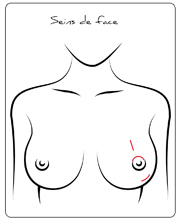Breast surgery
Adnexa surgery
Uterine surgery
Cervical surgery
Vulvar surgery
Other
Benign lumpectomy
Indication

Any tumor has to be diagnosed in order to know its nature. All benign breast tumors have their own clinical and radiological characteristics. Sometimes these medical approaches are not enough to know the exact nature of the tumor, and a tumorectomy (surgical remove of the tumor) is then mandatory. This will allow medical staff to analyze the tissues, and give the right diagnosis. More rarely, the tumorectomy is performed because of a major growth of the tumor, and the pain felt because of the tumor.
Surgical procedure
For this surgical procedure, the woman will have a general anesthesia. The aim of this surgery is to withdraw the tumor, with some of the tissue around it: the breast is conserved. Incisions can be made over the tumor or at more concealed locations like the edge of the areola or within the crease below the breast, in order to make sure the scarf is as discrete as possible. A catheter can be placed for a few days to prevent any hematoma. Most frequently, this surgery is practiced as an outpatient procedure (check in on morning / check out on afternoon). A 1 week work leave must be planned.
Risks & Complications
Even if surgery procedures and technics are meticulous, it is not possible to guarantee neither therapeutic success nor a complete absence of intraoperative complications.
During the surgery
Blood loss: may rarely lead to a blood transfusion.
Post-operative
- Blood tumor or abscess: It is a pocket of blood or pus that may sometimes lead to a surgery. A redon’s drain can be implanted per-operatory to avoid it.
Generally requires local care, but a surgical evacuation may be an option
- Cutaneous necrosis: it’s linked to a default of the healing process, and may rarely lead to another surgery.
Last update: 10/2/2012
